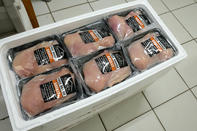Before starting a chicken venture, you need to think about what and where you are going to sell your produce.

You may decide to focus on egg production, meat production, the breeding of birds, the hatching of eggs or all of these if you farm with dual purpose birds. Remember though that each of these areas are highly specialised, so it might make sense to focus on only one of these areas if you want to go big.
Before you buy your birds or any equipment, you need to identify your target market, what the market wants, what it is willing to pay and how much it would cost you to produce this product. It would be even better if you are able to secure a market before you start production.
Broiler Market in South Africa

Birds produced for the meat market are referred to as broilers. The formal market is geared to take birds that weigh about 1,8 kilogram, whereas the fast food market wants slightly smaller birds.
The European and American markets want bigger birds than in South Africa, because they only eat the chicken breast meat and wings. The rest of the birds, such as the thighs and the drums, are regarded as by-products and exported.
The informal poultry market in South Africa may also prefer bigger birds and have a preference for specific chicken breeds. Some poultry breeders and egg producers also cash in on the market for spent-hens, which are mature female birds that have completed their egg producing or breeding cycle.
The breeders that are sold as spent hen are referred to as Cornish hens or Rocks in the townships. Spent hens are bigger, older and their meat is therefore tougher than the meat of birds that are sold as broilers.
Market Regulations
Other demands should also be considered. Birds have to be raised humanely and be safe to eat – that is non negotiable in any market.
Producers who want to supply the formal market generally have to comply with more stringent food safety and production standards than when they supply the informal market, these standards will also vary between different retailers.
Standards to sell birds as free-range will also differ between retailers and be even higher if you want to sell the birds as free-range organic, as this will have an impact on the type of feed and medicines that may be given to the birds.
Slaughter Age of Poultry

Another important question to consider is the age at which the birds will be sold. You need to calculate the cost of keeping the birds per day and identify the point where the birds have to be sold to prevent them from eating up all your profits.
This will be more important in a system where the birds are produced in an intensive production system where they receive expensive rations to accelerate their growth, than in a system where the birds are left to scavenge and fend for themselves.
break even points in intensive production systems usually lie somewhere between 32 days and six weeks.
Value-Adding to Poultry
Will the birds be sold live or dead? One of the benefits of selling slaughtered birds in the informal market is that it allows farmers to freeze stock to overcome times when there is low demand for the meat.
It might also allow them to add value to the meat by selling chicken pieces. The disadvantages are that freezing meat will drive up electricity costs, require expensive refrigeration and slaughter equipment as well as additional space.
On top of this, farmers are allowed to slaughter birds for own consumption, but not to sell it unless it is slaughtered in an approved abattoir, according to the Meat Safety Act.
Some farmers overcome this challenge by offering clients a place on their premises where the birds can be slaughtered, whereas others pull resources to establish their own abattoir and meat processing facilities.
Branding
